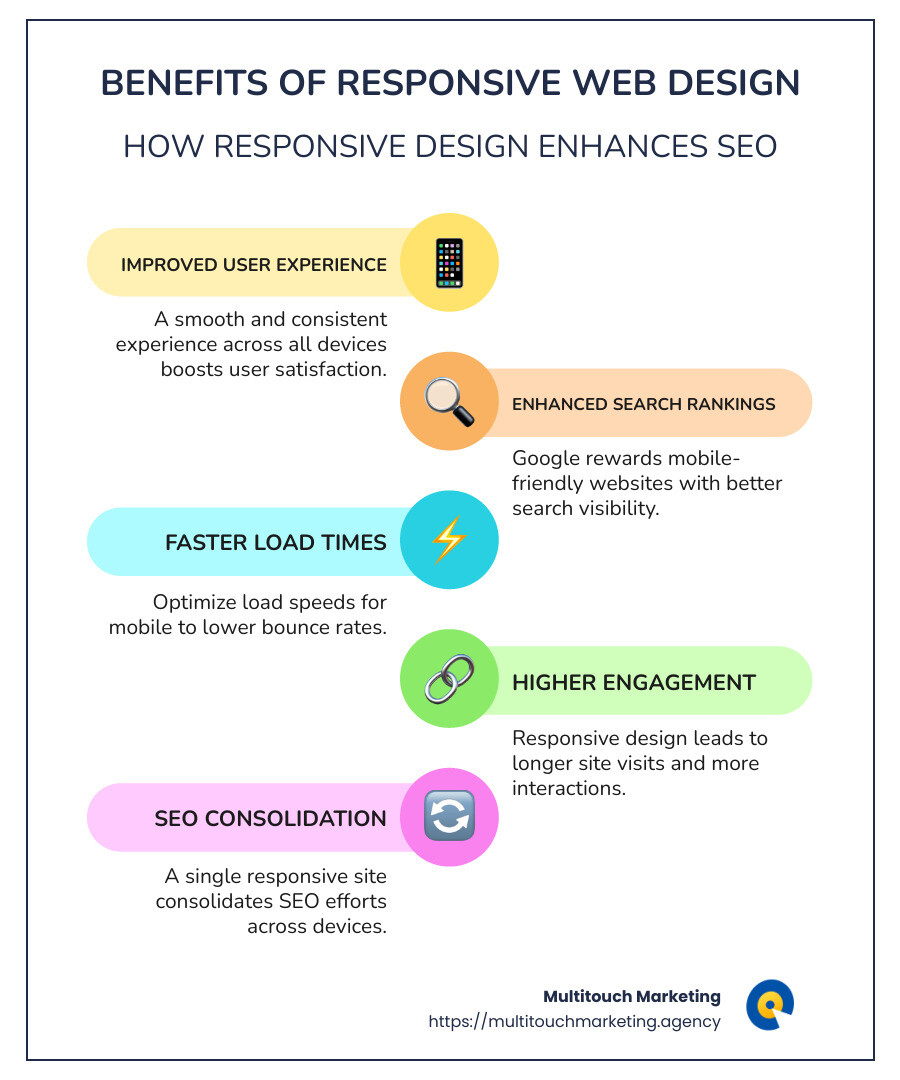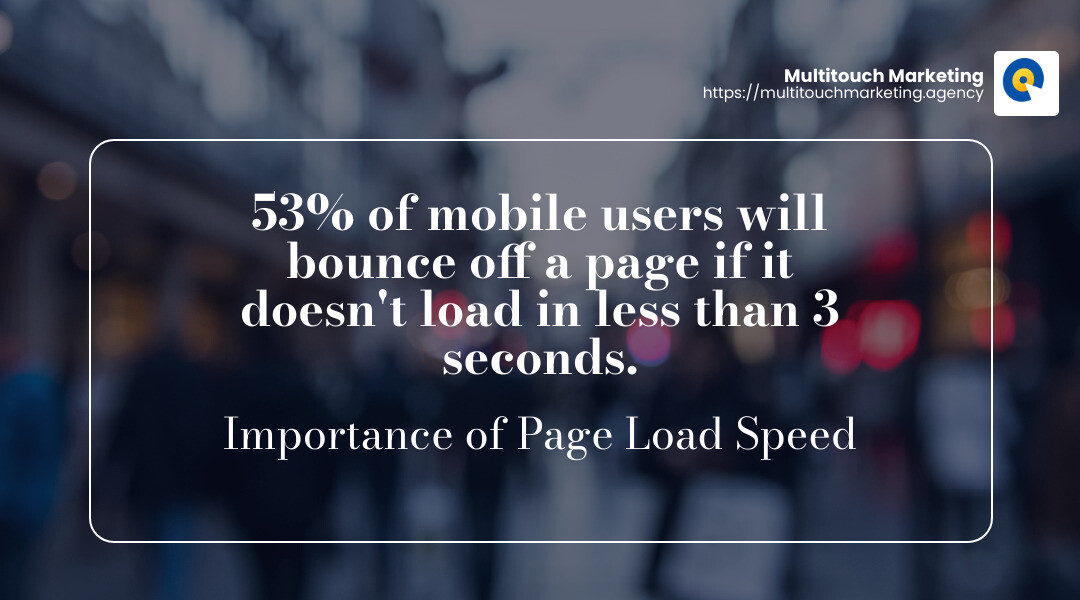Responsive Web Design and Search Engine Optimization: Top 5 Secrets for Unbeatable Success
Responsive web design and search engine optimization are keys to boosting your online visibility, delivering a better user experience, and fulfilling Google’s mobile-first indexing demands. It ensures:
- A smooth and consistent user experience across all devices
- Improved search engine rankings
- Faster load times
- Higher engagement and reduced bounce rates
In today’s mobile-centric world, having a website that adapts seamlessly to any screen size is not a luxury—it’s a necessity. Google increasingly rewards websites that are well-optimized for viewing on phones and tablets, which highlights the direct link between effective, responsive web design and search engine optimization success. Ignoring this alignment can severely impact your site’s visibility.
As Milton Brown, a seasoned digital marketer with in-depth expertise in responsive web design and search engine optimization, I have witnessed how a responsive approach can transform user engagement and improve search rankings. With over a decade of experience in developing data-driven strategies, I understand the profound impacts of leveraging cutting-edge technologies for superior SEO outcomes.
Understanding Responsive Web Design
Responsive web design is like magic for your website. It makes sure your site looks good and works well on any device, whether it’s a big desktop monitor or a small smartphone screen. This is crucial because, as of 2021, mobile devices account for nearly half of all web traffic globally.
Flexible Grids
Think of flexible grids as the skeleton of your website. They are the structure that holds everything together. With flexible grids, your website layout can adjust smoothly to fit any screen size. This means no more pinching and zooming on your phone to read tiny text! Instead, everything resizes automatically to provide a comfortable viewing experience.
Media Queries
Media queries are the secret sauce in responsive web design. They are like little detectives that check out the size of a user’s screen and tell the website how to display its content. For example, if someone visits your site on a tablet, media queries ensure that images, text, and menus are arranged perfectly for that screen size. This makes your site not only look great but also function seamlessly.
Why It Matters
Google recommends responsive web design for a good reason. It makes your site easier to steer and keeps visitors happy. A happy visitor is more likely to stick around, reducing your bounce rates and improving your search engine rankings. Plus, with Google’s mobile-first indexing, having a site that works well on mobile devices is more important than ever for SEO success.
In a nutshell, responsive web design is all about creating a smooth, user-friendly experience across all devices. It’s a key part of any solid SEO strategy and can make a big difference in how your website performs in search engine rankings.
Responsive Web Design and Search Engine Optimization
When it comes to responsive web design and search engine optimization, the benefits are clear. A responsive site improves your SEO efforts by ensuring a seamless user experience across all devices. This is crucial because Google has shifted to a mobile-first indexing approach, meaning that the mobile version of your site is now the primary version considered for indexing and ranking.
SEO Benefits
Responsive web design offers multiple SEO advantages. It eliminates the need for separate mobile and desktop versions of your site, which means you won’t have to worry about duplicate content issues. Instead, you have a single URL for each page, making it easier for search engines to crawl and index your site. This unified approach also simplifies link building, as all backlinks point to the same URL, consolidating your SEO efforts.
Moreover, a responsive design improves usability, which can lower bounce rates and increase the time visitors spend on your site. When users find your site easy to steer, they’re more likely to stay longer, engage with your content, and ultimately convert into customers. These positive user signals are noticed by search engines and can contribute to higher rankings.
Mobile-First Indexing
Google’s mobile-first indexing is a game-changer. With more users accessing the web via mobile devices, Google prioritizes the mobile version of your site when it comes to indexing and ranking. This means that if your site isn’t mobile-friendly, you could be missing out on valuable search traffic. A responsive design ensures your site is optimized for mobile users, providing a consistent and engaging experience across all devices.
Google Recommendations
Google has consistently recommended responsive web design as the preferred approach for mobile optimization. This is because a responsive site adapts to different screen sizes without the need for redirects or duplicate content. Google’s endorsement of responsive design underscores its importance in today’s digital landscape.
In summary, adopting responsive web design is not just about aesthetics or user experience—it’s a strategic move that can significantly impact your site’s SEO performance. As search engines continue to evolve, having a responsive site ensures you stay ahead of the curve and maintain strong visibility in search results.
Next, let’s explore the key benefits of responsive web design specifically for SEO.
Key Benefits of Responsive Web Design for SEO
Improves Usability
Responsive web design (RWD) is all about making websites easy to use on any device. Usability is crucial because it determines how easily visitors can find information and steer your site. When users have a smooth experience, they’re more likely to stick around and explore. This is important for SEO because search engines like Google track user behavior. If users stay longer on your site, it sends a positive signal that your content is valuable.
Reduces Bounce Rates
A high bounce rate can hurt your search rankings. It means users are leaving your site quickly, often because the page didn’t load fast enough or was hard to steer. Responsive design reduces bounce rates by providing a consistent and user-friendly experience, no matter the device.
“53% of mobile users will bounce off a page that is not loading in less than three seconds.”
Faster Load Speeds
Page speed is a critical factor for both user experience and SEO. Responsive web design helps your site load faster by optimizing images and layouts for different devices. Faster load times keep users engaged and reduce bounce rates. Google also considers page speed as a ranking factor, so a faster site can lead to better search rankings.
Consolidates SEO Efforts
With responsive design, you manage one URL and one codebase for all devices. This consolidates your SEO efforts, making it easier to optimize your site. You won’t need separate strategies for mobile and desktop versions, which can save time and reduce the risk of duplicate content issues. When all your backlinks point to a single URL, it strengthens your site’s authority and improves its SEO performance.
Improves Local SEO
Local searches are often performed on mobile devices. If your site is responsive, it will display correctly on smartphones and tablets, making it easier for local users to find you. A mobile-friendly site improves your chances of appearing in local search results, which is crucial for businesses looking to attract nearby customers.
Incorporating responsive web design into your SEO strategy is essential for improving usability, reducing bounce rates, and speeding up page loads. It also simplifies your SEO efforts and boosts your local search visibility. Understanding the differences between responsive and adaptive web design can help you make informed decisions about your site’s future. Let’s explore that next.
Responsive vs Adaptive Web Design
When it comes to building a website that looks great on any device, you have two main options: responsive design and adaptive design. Both aim to optimize how a site displays across devices, but they take different approaches to achieve this.
Responsive Design: The Liquid Layout
Imagine pouring water into a glass. No matter the shape or size of the glass, the water adjusts to fill it perfectly. This is how responsive web design works. It uses a single, flexible layout that automatically adapts to different screen sizes. This means your site will look good on a phone, tablet, or desktop without needing separate versions.
Benefits of Responsive Design:
- Consistency: One layout fits all devices, providing a seamless experience.
- Ease of Management: With only one codebase, updates are simpler and less time-consuming.
- SEO-Friendly: Google recommends responsive design because it consolidates your SEO efforts and avoids duplicate content issues.
Adaptive Design: Ice in a Glass
Now, think about filling a glass with ice cubes. Each cube is pre-shaped to fit a specific glass. Adaptive web design works similarly by using multiple layouts custom for different screen sizes. When a user visits your site, the server detects the device and serves the appropriate layout.
Benefits of Adaptive Design:
- Custom Experience: Each layout is optimized for a specific device, potentially offering a more custom experience.
- Control: Designers have precise control over how the site appears on different devices.
Choosing the Right Approach
So, which is better: responsive or adaptive design? It depends on your needs. Responsive design is often the go-to choice for its simplicity and SEO advantages. It’s like having a one-size-fits-all solution that grows with new devices and screen sizes.
On the other hand, adaptive design might be suitable for projects requiring highly customized experiences on certain devices. However, it can be more complex to maintain due to the need for multiple layouts.
In digital marketing, responsive web design is often the preferred choice. It aligns with Google’s recommendations and streamlines both the user experience and your SEO strategy. As you consider your website’s future, understanding these differences will help you make the best decision for your business.
Next, we’ll explore common questions about responsive web design and how it impacts SEO.
Frequently Asked Questions about Responsive Web Design and SEO
What is responsive web design?
Responsive web design is all about creating websites that look and work great on any device, whether it’s a desktop, tablet, or smartphone. Think of it as a flexible layout that adapts to different screen sizes seamlessly. This approach doesn’t just rearrange the design; it ensures that images, text, and buttons adjust automatically, making the site easy to use and steer.
Responsive web design is built using flexible grids and media queries. These tools allow the layout to change based on the device’s screen size. This means users get a consistent experience, no matter how they access your site. It’s like having a one-size-fits-all solution that ensures everyone sees your content in the best possible way.
How does responsive design affect SEO?
Responsive web design plays a crucial role in search engine optimization (SEO). Google has shifted to a mobile-first indexing approach, meaning it primarily uses the mobile version of a site for indexing and ranking. Having a mobile-friendly site is essential for good search rankings.
A responsive design improves user engagement by providing a smooth experience across all devices. When users find it easy to steer your site, they are more likely to stay longer and interact with your content. This reduces bounce rates and signals to search engines that your site is valuable and relevant.
Additionally, responsive design consolidates your SEO efforts. Instead of managing separate URLs for desktop and mobile, you have a single URL for all devices. This simplifies your strategy and avoids any duplicate content issues, making it easier for search engines to crawl and index your site.
Why is CSS important in responsive web design?
CSS, or Cascading Style Sheets, is the backbone of responsive web design. It controls the visual properties and styles of HTML elements on your site. With CSS, you can create flexible layouts that adjust to different screen sizes using media queries.
Media queries in CSS allow you to apply different styles based on the device’s characteristics, such as width and height. This means you can change the layout, font size, and even hide or show elements depending on the device. CSS ensures that your website looks good and functions well, no matter how users access it.
In short, CSS is essential for creating a responsive design that improves both user experience and SEO. It allows you to maintain a consistent look and feel across all devices, ensuring your site is visually appealing and easy to use.
By understanding these key aspects of responsive web design, you can create a website that not only looks great but also performs well in search rankings, providing a seamless experience for all users.
Need Help?
At Multitouch Marketing, we understand that the digital landscape is constantly evolving. That’s why we emphasize the importance of responsive web design and search engine optimization in our approach to digital marketing.
Responsive design isn’t just a trend; it’s a necessity. As we’ve discussed, it impacts everything from SEO to user experience. By ensuring your website is mobile-friendly, we’re helping you meet Google’s mobile-first indexing requirements. This approach not only improves your search rankings but also improves user engagement and reduces bounce rates.
Our expertise in PPC campaigns complements our focus on responsive design. By combining these strategies, we help businesses reach their target audience more effectively. A well-designed, responsive website can significantly boost the performance of your PPC campaigns, leading to higher conversion rates and better ROI.
In today’s digital world, having a website that adapts seamlessly to any device is crucial. It ensures your business remains competitive and accessible to a broader audience. At Multitouch Marketing, we’re committed to helping you achieve success by integrating responsive design into your digital marketing strategy.
Ready to take your website to the next level? Contact us today to learn more about how our responsive web design services can improve your online presence and drive results.
Your success is our priority, and we’re here to guide you every step of the way.




